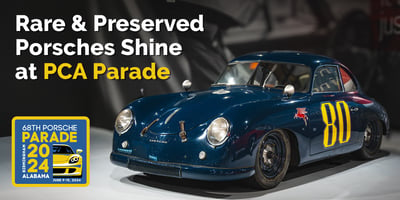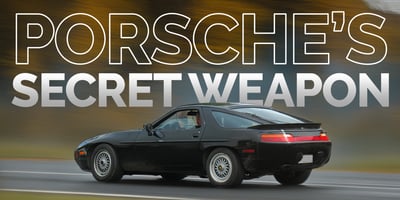The Porsche Club of America (PCA) occupies a deservedly exalted spot among the very best and most...
Ten of the Most Wanted Classic Porsches

What’s the most desired Porsche of all time? Ask ten different Porschephiles that question, and you will likely get ten different answers, from the purist’s choice of Gmund Coupe to the ultra-sought-after 2016 911R, with a few 917s, 956s, and 919s to boot. We’ve collected ten good answers to that question – but it would be equally easy to find ten more. After nearly eighty years of building world-class sports cars, Porsche has more #1 hits than John, Paul, George, and Ringo combined.
Short Wheelbase (SWB) 911, 1965-1968

They’re not the fastest Porsches to wear the 911 name. Quite the opposite, in fact – the early two-liter 911 has just 130 horsepower, and even the 1967 911S was modest by today’s standards with 160 horses from its uprated engine. The air-cooled, six-cylinder Porsche grand tourer underwent a program of continual improvement from its September 1964 introduction to its disappearance at the end of the 1998 model year, but many collectors are most interested in the first four of those years. We call them “SWB” now, to reflect the fact that the wheelbase was stretched just over two inches in 1969 to improve handling and safety. These early cars have the smallest six-cylinder engines ever fitted to a street 911, plenty of chrome detailing, and no rear fender flares. Don’t expect the casual Cars & Coffee passerby to know what you have… but the cognoscenti will know. These are very special cars.
1993 928 GTS

After a few decades spent in the barn-find wilderness, the early versions of Porsche’s V-8 flying saucer are finally getting the collector attention they’ve always deserved. The end-of-run 928GTS, on the other hand, never went out of style. To ensure their flagship could hold its head up in a model lineup filled with heavy hitters, Porsche used every trick in their usual book, from a displacement bump (5.4 liters and 345 horsepower against 5.0 and 326 of the 928GT) to flared fenders with wider tires. Built and finished to the highest standards possible, these final 928s sold for close to $100,000 thirty-plus years ago and are still selling for that much today. Few front-engined Porsches inspire more desire.
550 Spyder

Win on Sunday, sell on Monday; the race-bred, mid-engined 550 Spyder did plenty of the former but not much of the latter, with just 90 chassis built across four years. One of them, of course, went to James Dean, who died in it nine days after taking delivery and just three days before he was scheduled to race it for the first time. The beauty of the 550 was that you could win races and drive it home in relative comfort. Well, that’s not exactly right. The beauty of the 550 was also in… its beauty. Few cars have ever looked quite so right.
2016 911R

To be a 911 fancier is to be forever caught between two worlds. The race fan in you loves the GT models, with their powerful engines and tremendous pace on both track and road, but your inner aesthete would rather have the classic fastback shape unspoiled by… spoilers. And a little comfort would be nice, as well. Which explains why the 911R sold out the moment it was announced. With the powertrain of the all-conquering GT3RS but a wing-free body with an interior that paid tribute to the lovely cloth-and-steel cockpits of early air-cooled Porsches, this 911 was the best of both worlds. Did we mention it weighs 113 pounds less than a GT3RS? This formula would be used again by Porsche in the years after, with the popular GT3 Touring, but the 911R remains the supreme water-cooled 911.
1956 356 A Carrera

Don’t be fooled by the model name – the “A” variant of the 356 was the second major version of Porsche’s original grand tourer. The split windshield of the early car gave way to a modern single piece of glass, curved appropriately. The entry-level 356A offered 44 horsepower from a 1300cc engine, but you could more than double that by choosing the 1500 Carrera. The famous Ernst Fuhrmann put four cams and twin distributors on this high-strung engine and got 100 horses in exchange, making this very much the king of the early Autobahn. The “Carrera” name, of course, would go on to have a very long career at Porsche.
1988 944 Turbo S Silver Rose

To drive a Silver Rose is to understand why some people at Porsche expected the 911 would be put out to pasture. It’s more powerful than a 911 Carrera of the same year, better balanced, and much faster both on a backroad and a racetrack. All the 924 and 944’s best features, like near-perfect visibility, driving position, and steering, were put into hyperfocus by a 247-horse engine, 30 horses more than the already-quick 944 Turbo and a full 100 more than the base 944. Not all Turbo S examples were Silver Rose with red plaid interior, but that’s how most people experienced the car for the first time, and that’s why it’s arguably the most sought-after regular-production 944 variant in the United States.
Carrera GT

The first Porsche supercar, the 959, took the 911 formula to its logical conclusion, with all-wheel-drive, massive turbo power, and aero refinements. The next one, by contrast, would draw its inspiration from racing Porsches, not street going ones. 1,270 examples were made, each with a screaming V-10, a manual transmission, and a carbon-fiber chassis. Later Porsches would match its performance numbers, but always by taking the 959 route of turbo power and additional traction. The “CGT” continues to stand alone as a GT1 prototype for the street.
1973 Carrera RS 2.7

How time flies! Just 16 years after the 356 A Carrera, Porsche would reuse the name on this 2.7-liter, “ducktail”-equipped 911 with more than twice as much power and a serious racing pedigree. Everything the firm knew about competing with rear-engined cars was apparent in the Carrera, which was envisioned as a 500-unit homologation special before being approved for series production. Fifty years later, the same formula of “add rear spoiler and flare the rear fenders” is still in use for track-focused 911s. This is where it began. It would be more than a decade before naturally-aspirated 911s would once again make this kind of power. They, too, would be called “Carrera”.
1964 904 Carrera GTS

Many cars, and many Porsches, have claimed to be “race cars for the street”. Certainly, it was true of the 904, which used a two-liter, 180-horse version of the Fuhrmann flat-four engine to power a futuristic combination of ladder frame and aerodynamic fiberglass body. Weight was around 1,500 pounds, and top speed soared to 160mph. Contemporary buyers must have felt the world around them was going in slow motion. Not satisfied with this level of performance, Porsche went on to put six- and eight-cylinder engines in a few 904s. The 904’s performance and looks inspired any number of VW-engined kit cars, but the real thing still commands millions of dollars on the rare occasions that one enters the auction rolls.
1948 Gmünd Coupe

If you’ve ever owned a made-in-Finland Boxster, or a Slovakia-built Cayenne, don’t feel too bad about not having that German heritage, because some of the most valuable Porsches ever made were constructed in an Austrian sawmill at the end of the Second World War. The very first Porsche sports car was a mid-engined, aluminum-body roadster, but the next 44 coupes, and 5 cabriolets, were rear-engined. Massaging the 25-horse 1100cc VW engine yielded first 35, then 40 horsepower. A hand-beaten aluminum body rested on a steel boxed frame. These early cars set a basic template from which Porsche would rarely deviate over the next seventy-five years, and their excellence was obvious even from first impressions. Encouraged by the reception accorded the Gmund Coupe and Cabriolet, Porsche returned to Stuttgart to start series production… and the rest of history.




